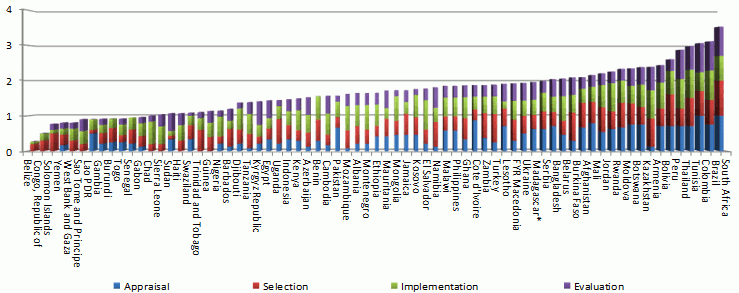The broad consensus is that the massive infrastructure deficit in many developing countries is a key bottleneck to their growth prospects. In many low-income countries in particular, deficiencies in infrastructure, especially in energy, roads, and communication, reduce productivity at least as much as structural factors, such as bureaucracy, corruption, and lack of financing. Arguments for significantly boosting investment in physical infrastructure to achieve sustained growth rest on the high returns to investment in capital-scarce environments, and the pressing deficiencies in these areas. But, is investment spending a good proxy for the accumulation of productive assets in developing countries? What do we know about the efficiency of public investment in these countries?
The link between public investment and growth
Pritchett (2000) convincingly argued that the notion that public investment spending is equal to capital accumulation is a heroic assumption in many developing countries as public investment is not inherently productive. All too often, inefficiency, waste, or corruption, distort the impact of public spending on capital accumulation. Examples abound of unfinished roads leading to nowhere, incomplete bridges and power generation projects, and other white-elephant projects. Private investment returns, in turn, are lowered by the lack of complementary public inputs. Not surprisingly, the much anticipated growth dividends fail to materialise.
The empirical literature on the link between public investment and growth is far from unanimous. Recent studies, especially those using the physical indicators of infrastructure, find significantly positive effects of public capital on growth. In contrast, findings are less robust among studies that use public investment flows or their cumulative value. This likely reflects that investment spending may be a poor proxy for the accumulation of productive assets in developing countries owing to waste and inefficiencies.
Constructing a Public Investment Management Index (PIMI)
The importance of public investment efficiency for development outcomes highlights the need to better understand the broad institutional framework underpinning the provision of investment. To this end, in a recent paper (Dabla-Norris et al. 2011) we provide a first attempt to identify the strength of the public investment management process in developing countries. Relying on an extensive data collection effort from multiple sources, we construct a composite index – the Public Investment Management Efficiency index (PIMI) – of the strength of investment process for 71 developing countries, including 40 low-income countries.
Country efforts to “invest in the investment process” encompasses several aspects or stages – country capacity to carry out technically sound and non-politicised project appraisal and selection, appropriate mechanisms for implementation, oversight, and monitoring of investment projects, and ex post evaluation. We create sub-indices that aggregate indicators across these four stages of the investment process: project appraisal, selection, implementation, and evaluation. The first stage, project appraisal, ensures investments are chosen based on development policy priorities. The second stage captures the extent to which project selection is linked to the budget cycle – country experiences find opaque organisational arrangements result in chronic under-execution of investment budgets, rent seeking, and corruption. Project implementation covers a range of aspects, from timely budget execution and efficient procurement to sound internal budgetary monitoring and control. The last stage, ex post evaluation of projects compares the project’s costs with those established during project design.
We scored countries on each of the stages (each of the stages is made up of several individual components, 17 in total). The different components were scored and combined to construct the overall PIMI. A scale between 0 and 4 was used for each question (most data is qualitative), with a higher score reflecting better public investment management performance.
PIMI scores
- The 5 countries with the most efficient investment processes are middle-income (South Africa, Brazil, Colombia, Tunisia and Thailand), and the weakest performers (Belize, Congo-Brazzaville, Solomon Islands, Yemen, and the West Bank and Gaza) are largely low-income countries (Figure 1). Although low-income countries score on average lower than middle-income countries, this masks significant cross-country variation; for example both Bolivia and Rwanda have PIMI scores above 2, scoring higher than 19 middle-income countries. The overlap of scores across the two groups begs the question why relative strengths in investment efficiency in some low-income countries do not translate into higher per capita GDP.
Figure 1. PIMI overall index: Decomposition by sub-index
- Beyond the large cross-country variation in overall scores, there is even more variation in sub-indices (Figure 1 also decomposes the overall PIMI scores across the four investment stages). Middle- and low-income countries, on average, exhibit comparable scores for the project implementation stage of the investment process, while the largest differences are in the project appraisal, selection and evaluation stages.
- Across regions, Eastern European and Central Asian countries have relatively more developed public investment management processes, followed by Latin America and Eastern Asia and the Pacific, while the Middle East and North Africa and Sub-Saharan Africa trail behind. Sub-Saharan African countries in particular are characterised by weaknesses in all stages of the public investment management process, although with substantial cross-country variation.
- Oil exporters have lower PIMI scores than other countries. This correlation between poor institutional quality and natural resource wealth is documented in the literature (Collier and Venables 2008). The idea is resource revenue windfalls increase incentives to misappropriate funds, and discourage incentives for sound institutional and public investment management processes.
Applying PIMI
PIMI could be used to study a broad range of questions in the literature and could potentially add value to the often-inconclusive empirical evidence on the public investment-growth nexus. Potential applications include cross-country growth estimations to test the efficiency with which public capital stocks are used and subsequently affect growth, including interactions between PIMI and other institutional and policy variables. Another potential application of the investment efficiency index is in the valuation of capital stocks. More broadly, incorporating PIMI into macro models of development is a notable avenue of future research that is likely to generate new knowledge and inform the policy debate.
Conclusion
In the current environment of abundant liquidity and search for yield, and the growing importance of BRICs as sources of foreign direct investment and aid, low-income countries have access to financing like never before. It will be important that they leverage it to close the infrastructure gap and increase growth. "Investing in the investment process" will ensure that the much-needed scaling-up of investment leads to future sustained prosperity rather than roads and bridges that lead to nowhere.
References
Collier, P and A Venables (2008), “Managing Resource Revenues: Lessons for Low IncomCountries”, African Economic Research Consortium.
Dabla-Norris, E, J Brumby, A Kyobe, Z Mills, and C Papageorgiou (2011), “Investing in Public Investment: An Index of Public Investment Efficiency”, IMF Working Paper 11/37.
Pritchett, L (2000), “The Tyranny of Concepts: CUDIE (Cumulated, Depreciated, Investment Effort) Is Not Capital”, Journal of Economic Growth, 5:361-384.








